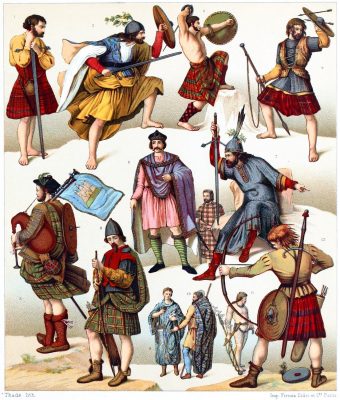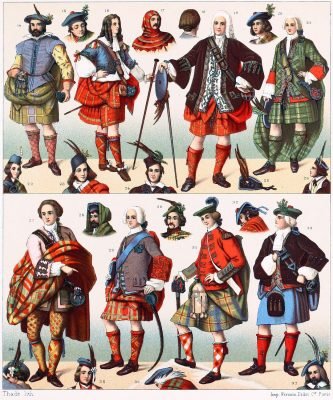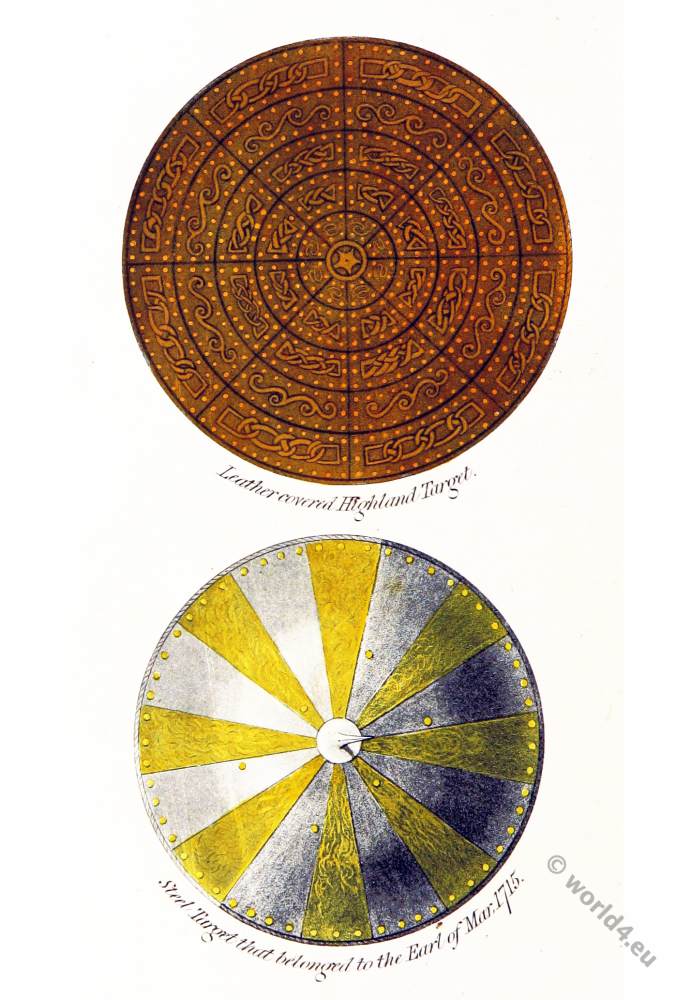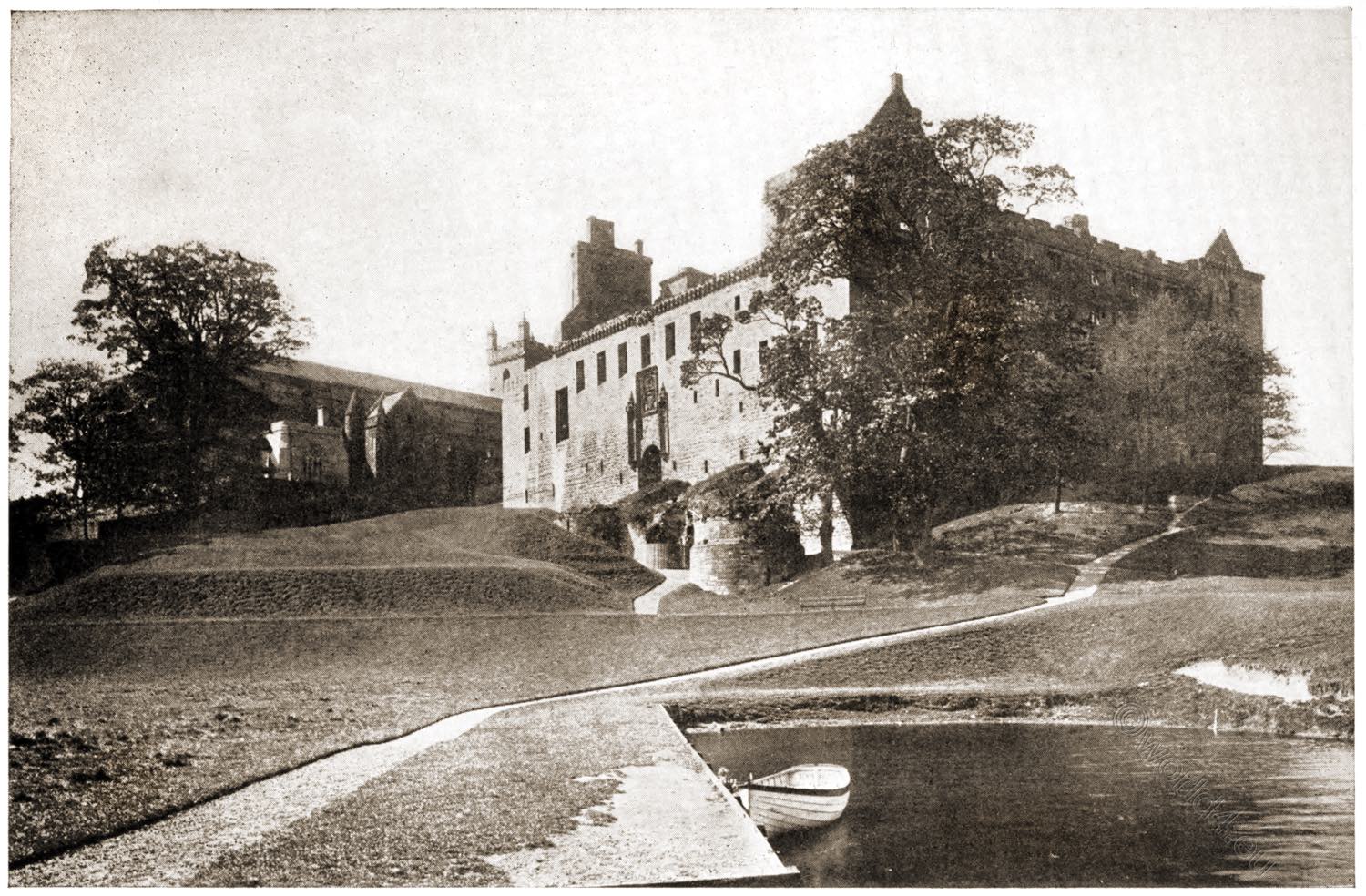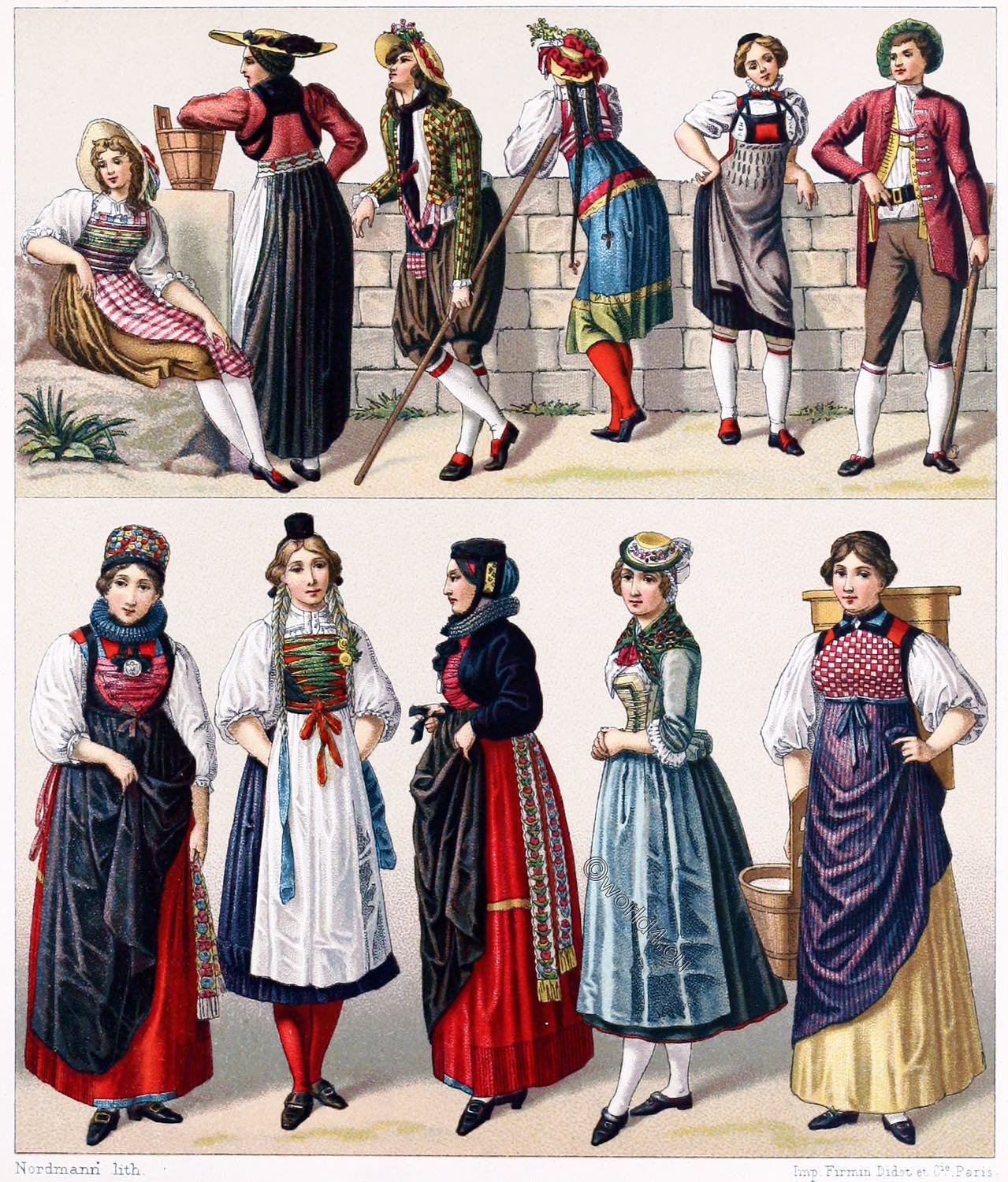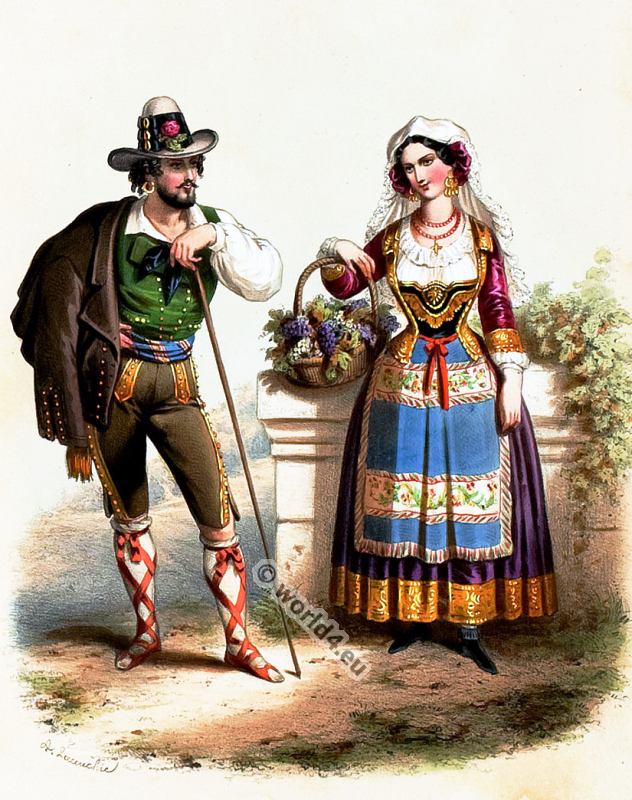SCOTLAND. NATIONAL COSTUMES.
IRISH BARDS, WARRIORS OF PAGAN TIMES, CHIEFS, WARRIORS AND FARMERS FROM THE MIDDLE AGES TO OUR DAYS; THE BREACAN OF THE CLAN.
The ancient Scottish customs, especially the organisation of the clan, have been preserved longest and purest among the Highlanders. The clan, a middle ground between tribe and family, is a group whose members all bear the same name with the prefix mac (son). A laird or chieftain is at the head.
The manufacture of tartan and plaid by the Bretons is extremely old. The combination of colours and patterns, in so far as they are considered to be the insignia of the different clans, is called breacan. The law of Ilbreachta (the multicolour) also stipulated that peasants and warriors were allowed to wear one colour, officers two colours and chiefs three. The Beatachs and Bruighnibs, the nobles, were allowed four colours, the even nobler five, the Ollambs or wise men six, and the royal family seven. Each clan also had a particular flower or branch as a badge.
At the beginning of the 18th century, the customs of the highlanders had remained completely intact. After the suppression of the uprising for the Stuarts in 1745, they were forbidden to wear the national costume, a ban that was not lifted again until 1782.
- No. 1 – Clan Mac Dugal of Lorn. Costume of the old Gaelen: Flannel blouse; petticoat (fheilebeag); belt pouch (sporran); 5 feet 8 inch sword (claymore); dagger.
- No. 2 – Clan Ferguson. Saffron shirt (flax croich), privilege of the druineusual or nobles; helmet (clogaid) with the branch of the Ferguson; shield (targaid) made of wood covered with several layers of flax, with buckle (capan) and handle; sword (claidheamh mòr).
- No. 3 – Clan Mac Millan. Calf stockings (moggans); underskirt kilt or fheile-beag; short sword (cliabh) with moggans; targaid with double handle.
- No. 4 – Clan Mac Inne. Warrior, the throwing spear (aseth) with fist strap in hand; fur jacket; targaid with capan; chain mail over the kilt made of flannel.
- No. 5 – Clan Mac Cruimin, to which the pipers belong. Round cap (bonaid-gorm); cross-wrapped plaid (breacan-fheile); jacket with silver embroidery; fur ribbon; claymore with scoop; lace-up suede shoes (cuarans).
- No. 6 – Clan Mac Coll. From a mosaic from the time of Charlemagne. Mitre-shaped cap; chlamys or sagum-like coat; collar; short, belted tunic; stockings held by gold rings; bootees.
- No. 7 – Clan Mac Donald from the islands. The laird holds a court day on the Tom Moid, the mountain of law. Next to him a baron in a checked tunic. Long chain mail (lurich); under it a similar one made of leather; arms and legs showing the breacan of the clan; clogaid with stone-studded rings, eagle wings and twig; collar made of braided leather.
- No. 8 – Clan Mac Laurin; chief from the beginning of the Middle Ages. This archer wears a conical clogaid; under a silk doublet the lurich; breacan-fheile in the colours of the clan; cuarans; bow and quiver made of badger skin.
- No. 9 – Awenydd (often a poet or a fortune teller) of the Roman period, as well as nos. 10 and 11. bard student, inspired by Awen, the spirit of poetry. The colours of the bards are blue-green and white. He carries in his right hand a cup with the holy juice (gewin-a-bragaivd), in his left hand the bird, the symbol of the student.
- No 10 – Irish ollam (bard). Saffron yellow shirt with embroideries according to rank; long hooded coat (cochal), white, blue, green and red stripes; blue trousers; leather shoes; the headgear was usually a hood (barrad), at high feasts the tiara.
- No. 11 – Picte with the aseth (cf. No. 4), at the end of which is a bronze ball filled with pieces of metal (oropstara) to rattle when the cavalry approaches. The body is tattooed. Necklace and chain belt.
- No. 12 – Clan of the Mac Qaaries. Archer of the 16th century (cearnaich); dressed with a jacket slit at the shoulder, the fheilebeag and the cuarans. The large two-handed sword hangs on the back, the targaid with capan on a hook on the string.
- No. 14 – Laird of the Skenen clan, dressed according to the fashion of 1587-1605 under Jacob VI, later Jacob I of England. The COSTUME shows the Spanish style with all the important characteristics of the national costume retained.
- No. 15 – Clan of the Graennen.
- No. 16 – Clan Robertson. Portrait of a Scottish nobleman at the court of Louis XIV, who knows how to combine court costume with national costume.
- No. 17 – Clan Mac Ivor
- No. 18 – Clan of the Grant of Glenmoriston.
- No. 19 – Clan of the Mac Intoshes, court dress from the beginning of the 18th century.
- No. 20 – Clan Mac Leod
- No. 21 – The Forbes. Court dress from 1740.
- No. 22 – Clan Mac Donell of Glengarry The cap form (glengarry) is from the beginning of the 19th century.
- No. 23 – Clan of the Frasers.
- No. 24 – The Chisholms.
- No. 25 – Glengarry seen from the side; Clan of the Campbells of Breadalbane.
- No. 26 – The Menzies
- No. 27 – Clan of the Ogilvies costume from 1745.
- No. 28 – The Davidsons
- No. 29 – The Stuarts Portrait of Charles Edward, the pretender from 1745. Velvet cap with white cockade; cordon of the Order of St Andrew; star of the Order of the Garter.
- No. 30 – Clan Buchanan.
- No. 31 – The Kennedys.
William, Earl of Sutherland. The uniform is that of the regiment he formed in 1759.
- No. 32 – Clan of the Mac Machtans.
- No. 33 – The Mac Intires; 18th century. A costume that tries to circumvent the Prohibition Act of 1746 and hide the peculiarities of the national costume.
The time of Charles I.
- No. 34 – The Murrays.
- No. 35 – The Mac Donald of the Ranald clan.
- No. 36 – The Mac Aulays
- No. 37 – Clan Mac Lean
No. 9. 10 and 11 from the work of Meyrick and Smith on the old Bretons. All other figures after The Clans of the Scottish Highlands; drawings by Robert Ronald M. Jan; text by James Logan, London 1857.
Source: History of the costume in chronological development by Auguste Racinet. Edited by Adolf Rosenberg. Berlin 1888.

